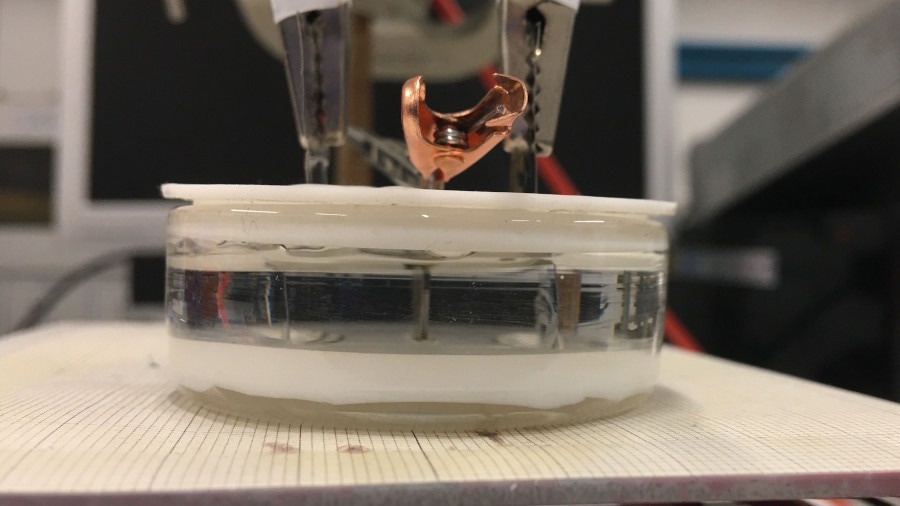Wireless technology has been successfully introduced to the fundamental level of magnetic devices by researchers at the ICMAB and UAB. The findings, which were published in Nature Communications, demonstrate how voltage can be used to control the magnetic properties of initially non-magnetic cobalt nitride layers. This paradigm shift could pave the way for the development of magnetic nanorobots for use in biomedicine and computing systems where wiring is not necessary for basic information management functions.
 Experimental setup. A thin layer of cobalt nitride (CoN) in a liquid with ionic conductivity. The voltage is applied to the liquid via two platinum plates. Image Credit: The Autonomous University of Barcelona
Experimental setup. A thin layer of cobalt nitride (CoN) in a liquid with ionic conductivity. The voltage is applied to the liquid via two platinum plates. Image Credit: The Autonomous University of Barcelona
Electronic devices, whether for processing or storing information, rely on changing the electrical and magnetic properties of components. Since current heat circuits, controlling magnetism with voltage rather than electric currents has become an essential control method to increase energy efficiency in many devices. Much research has been conducted in recent years to develop techniques for applying voltages to carry out this control, but always by electrical connections directly to the materials.
With the help of the Institute of Microelectronics of Barcelona CNM-CSIC, the ALBA synchrotron, and the UAB Department of Physics, a research team led by members of ICMAB and the Department of Physics has successfully altered the magnetic properties of a thin layer of cobalt nitride (CoN) for the first time by applying electrical voltage without the need for wires.
To accomplish this, the magnetic material sample was submerged in an ionic conductivity liquid, and two platinum plates were used to apply voltage to the liquid without having to connect any wires to the sample itself.
The nitrogen ions left the CoN as a result of the induced electric field that was created, and the sample transformed from non-magnetic to magnetic. In addition to manipulating the actuation time and applied voltage, sample arrangement can also be used to control the induced magnetic properties. Depending on how the sample is oriented concerning the applied electric field, magnetism can be changed either permanently or temporarily.
Being able wirelessly to control the magnetism of a sample by modifying the voltage represents a paradigm shift in this area of research. This is a finding that could have applications in a wide range of fields such as biomedicine, to control the magnetic properties of nanorobots without wires, or in wireless computing, to write and erase information in magnetic memories with voltage but without wiring.
Jordi Sort, Researcher, Department of Physics, The Autonomous University of Barcelona
The researchers’ approach to achieving wireless magnetic control is not limited to the cobalt nitride material they utilized for their experiments.
These protocols can be extrapolated to other materials to control other physical properties wirelessly, such as superconductivity, memristor control, catalysis or transitions between insulator and metal, as well as wireless electrodes for neuronal electrostimulation, to cite a few examples that can expand the scope of application and technological impact of this research.
Nieves Casañ-Pastor, Researcher, Institute of Materials Science of Barcelona, The Autonomous University of Barcelona
The study, which was recently published in the most recent issue of Nature Communications, was led by ICREA researcher Jordi Sort of the UAB Department of Physics and researcher Nieves Casañ-Pastor of the Institute of Microelectronics of Barcelona CNM-CSIC. Zheng-Ma of the UAB Department of Physics and Laura Fuentes of the Institute of Microelectronics of Barcelona CNM-CSIC, both first authors of the research article, were also involved, as were Zhengwei Tan, Eva Pellicer, and Enric Menéndez of the UAB Department of Physics; Libertad Abad of the Institute of Microelectronics of Barcelona CNM-CSIC; and Javier Herrero Martín of the ALBA synchrotron also participated in the study.
Journal Reference:
Ma, Z., et al. (2023) Wireless magneto-ionics: voltage control of magnetism by bipolar electrochemistry. Nature Communications. doi:10.1038/s41467-023-42206-5